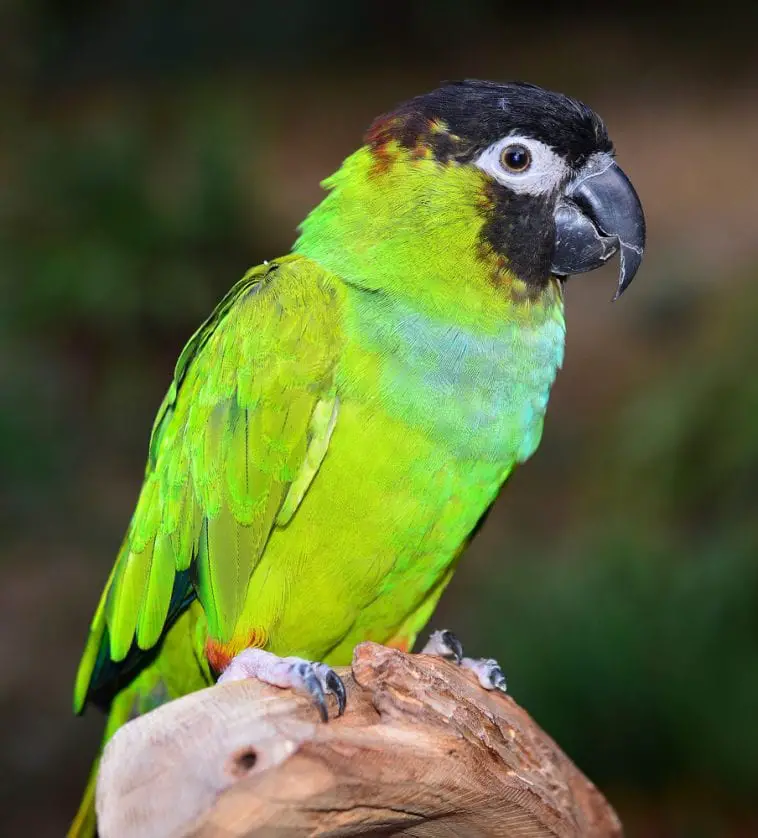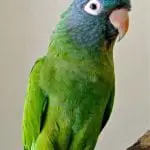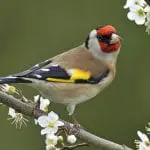Scientific Name
| Common Name | Nanday Conure |
| Scientific Name | Aratinga Monday |
| Origin | Southeast Bolivia, South America, southwest Brazil, northern Argentina, central Paraguay, northern Argentina. To further increase their territory, their populations are scattered through San Antonio, Texas, Los Angeles, California, and in several areas of Florida |
| Habitat | Tropical and wetland environment. They mostly thrive in the wetter forest and cooler woodlands, mountainous and bushland parts of South America. |
| Diet | Berries, nuts, flowers, fruits, insects, grains, grass seeds, flower buds, and special pelleted seeds. |
| Size and Weight | about 15 inches (37 centimeters) making them a small-medium sized parrot |
| Life Span | up to 15 years in the wild, but in captivity, as long as they are given the right care, they can live up to 20 years. |
Physical Description
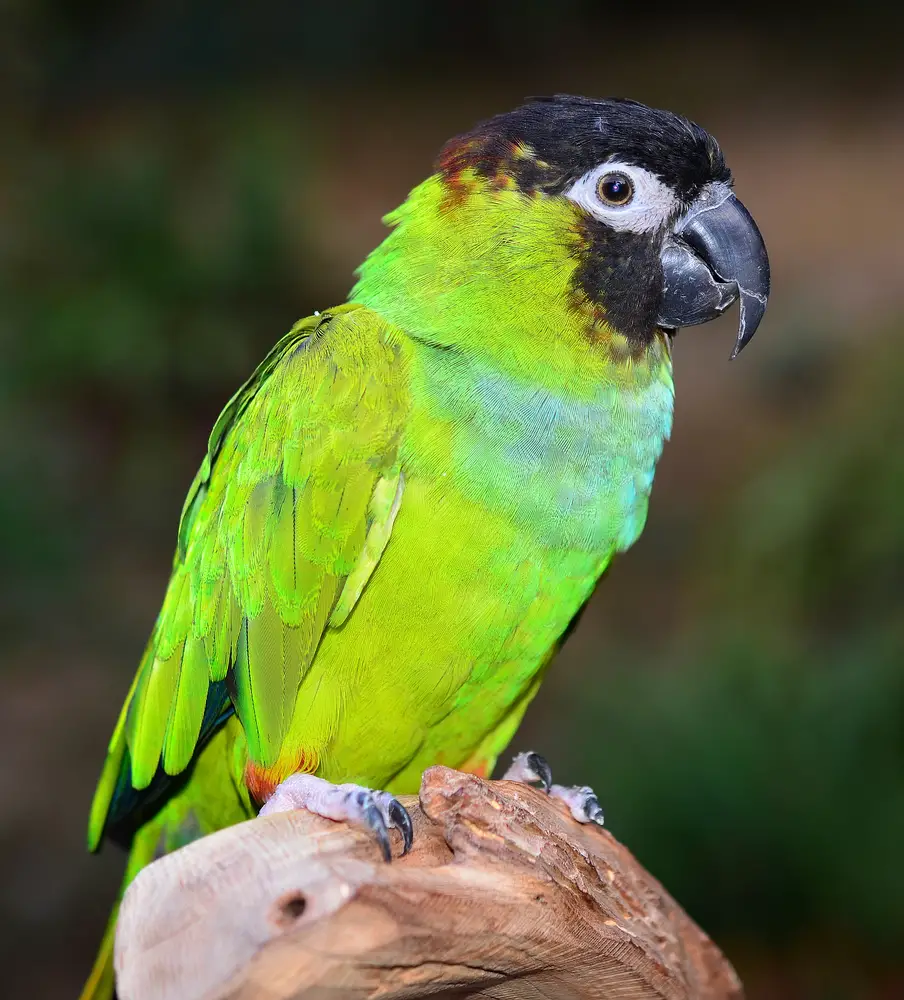
The Nanday Conure or known as the Monday parakeet or black-hooded parakeet is a small-medium parrot species that have a tropical color combination with the green color being prominent with black markings; that is why it is known as a parrot with a whirlwind of vibrant hues. They are also called the black hooded conure because of the appearance of their beak and face, which is rounded.
They are also easily distinguished through their bright orange feathers on their legs. Some describe them as a funny bird because of their light blue patch on the chest and wings with a distinct red color on their thighs. All the color combinations on their body have distinct patterns that make them unique. The only way to differentiate male and female is through DNA testing because males and females do not have major differences
Where it is Seen?
This bird is a native to Southeast Bolivia, South America, southwest Brazil, northern Argentina, central Paraguay, northern Argentina. To further increase their territory, their populations are scattered through San Antonio, Texas, Los Angeles, California, and in several areas of Florida.
Habitat
They thrive in places that have tropical and wetland environments. They mostly thrive in the wetter forest and cooler woodlands, mountainous and bushland parts of South America. During the winter season, they would usually migrate to other places where there is a more friendly atmosphere for them, but as soon as the season changes, they’ll move back to their main habitat which is a dense forest where they can breed since they need the help of trees to breed. During the spring and summer season, they are mostly seen in woodlands and tall mountain forests that are highly timbered. During the winter and autumn season, they would go to lower altitudes for them to keep their bodies drier in open forest, usually in coastal areas in urban places.
Behavior and Temperament
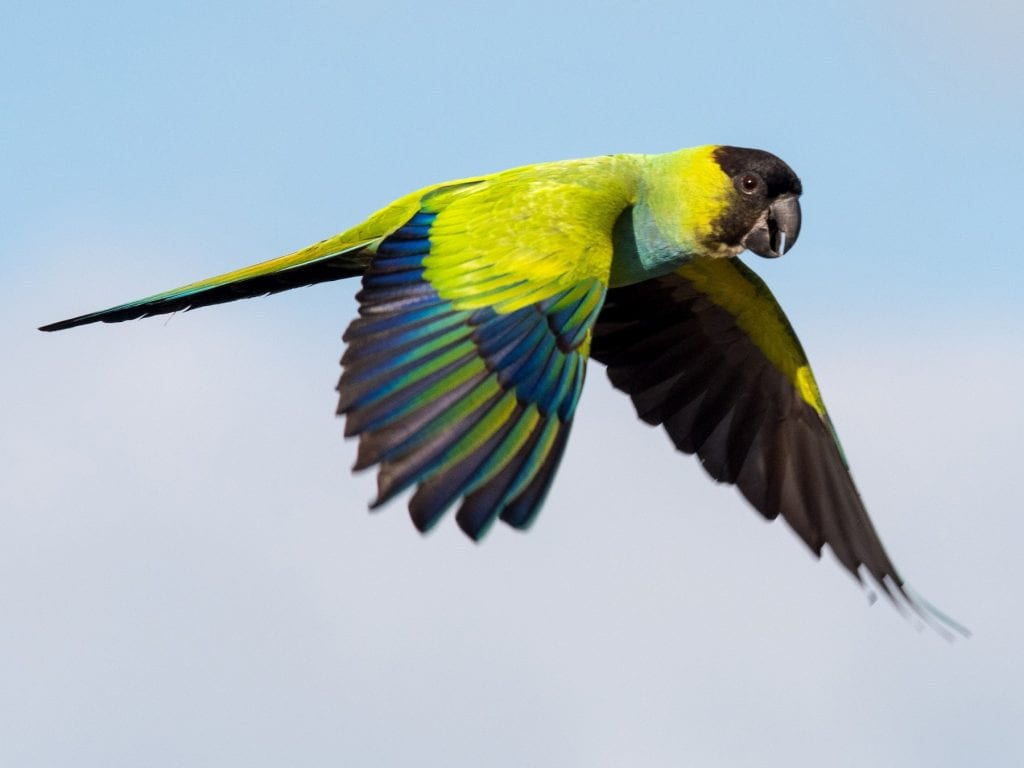
Their behavior and temperament do not differ much from other parrot species. They love doing speech and sounds, that is their high pitch natural calls. They usually make noise when they seek attention and if there is something wrong that irritates them. With proper training, they are able to talk and mimic sounds done by humans in a cartoonish and comical way that can be fun, making them have a characteristic that has a clown-like personality.
In captivity, they show off their playfulness by means of messing and tumbling things around. One of their distinct behaviors is that they can fall asleep on their backs with their that sticking straight out, making them look like dead. When they used to grow up socializing, they can be tamed easily, and they can go with strangers out of curiosity. In captivity, they require more time outside of their cage to fully develop their mental and physical well-being.
Breeding and Reproduction
Nanday conure is sexually active at the age of 3 years old. Like other parrots, they build their nest in hollows of a mature tree that can accommodate their 2 to 6 white eggs that are expected to hatch at about 25 days, during this time frame, the females incubate it while the males tend to guard the nest and they are the ones who will feed the females and their young ones.
Diet
In the wild, the Nanday Conure feeds most commonly on flowers, berries, nuts, fruits, insects, grains, grass seeds, and flower buds. The wide diet variety and the extreme amount of food that is available to the Nanday Conure in the wild are not necessarily healthy for the Nanday Conure being kept in captivity; however, since exercise levels are limited in captivity.
Most commonly, when kept in captivity, the Nanday Conure is fed with a special pellet diet formulated specifically for the Nanday Conure. The benefit of feeding this type of diet is that the food is nutritionally formulated to suit the needs of the Nanday Conure. There is, however, a couple of drawbacks to feeding only a pellet based diet; most commonly, the biggest issue with this diet is that soon, your bird will become bored and no longer interested in their food.
Size and Weight
Their maximum length reaches about 15 inches (37 centimeters), making them a small-medium sized parrot with long tail feathers.
Lifespan
In the wild, they can live up to 15 years, but in captivity, as long as they are given the right care, they can live up to 20 years.
Common Diseases/Illnesses
1) Overweight parrot
When the parrot looks fat, it doesn’t mean that they are healthy. Being fat is next to being overweight or obese, which is an unhealthy physical physique for a bird because it can be a cause of different diseases or illnesses. Overweight is due to an improper way of feeding them, may it be the schedule of feeding or the variety of foods that are given to them. The more healthy options, the less likely that they’ll be overweight. If your parrot’s body is too heavy, they’ll have difficulty moving, restricting them from moving properly. You may need to consult your veterinarian for the list of foods that can be given to them, just avoid sugary and fatty-based diets.
2) Avian Gastric Yeast (AGY) infection (megabacteriosis)
This disease targets the ability of your parrot to digest food because of the bacterial and yeast infection leading to weight loss. It is quite difficult to identify if your parrot has an Avian Gastric Yeast (AGY) infection (megabacteriosis), especially during the first phases because your parrot will not lose weight at once. You may need to observe them carefully. As soon as you see undigested food from their feces or vomit, this is already a sign that they have a problem digesting it. Your veterinary would advise you to give them antibiotics for about a week so as to kill the bacteria and replace the good cells that had been infested.
3) Aspergillus
This is a respiratory disease among parrots that target the functioning of their lungs and air sacs that affects the way how they inhale and exhale air. This is usually caused by changing temperature and exposure from damp conditions where bacteria had already been flourished. When your parrot has an audible wheeze with a mucous discharge in their nostrils, you must carefully observe them because they are already having difficulty in breathing. This is a serious condition because it is fatal.
4) Nutritional Deficiencies
In captivity, it is already a drill to give them one variety of food which is the pelleted ones, there are pelleted seeds that are of good quality that is enriched with different kinds of nutrients but there are also pelleted seeds that lack certain nutrients, if this is the kind of food that you will give them, most likely they’ll have a nutritional deficiency. The most number of recorded nutrients are calcium or Hypocalcaemia. Calcium plays an important role in making the parrot active. Calcium is also a component that makes the eggs of the females strong and difficult to break.
5) Candida virus (Thrush), or Candidiasis
Another disease caused by a yeast infection is the candidiasis where the digestive tract of the parrot is infested. It is a disease of birds that is highly transmissible to humans; that is why it is important to detect it earlier to avoid further infections. The manifestations of this disease are mucous discharge, colds, and wheezing that is accompanied by red eyes. The use of antibiotics can be helpful in treating this disease.
6) Macaw Wasting Syndrome, or Proventricular Dilatation syndrome
This is a digestive disease that targets the functioning of the stomach, especially in digesting food. Bas the parrot suffers from this disease, the more it is losing weight. It is commonly mistaken as an Avian Gastric Yeast, but the difference is that Macaw Wasting Syndrome is due to irregularities in the parrot’s hormones while the Avian Gastric Yeast is due to yeast and bacterial infections. If this disease is not attended to earlier, it can lead to fatality because there will be no nutrients for the parrot to digest.
7) Polyoma
This is a disease that affects different kinds of bodily functioning. If your parrot suffers from this disease, they may suffer from hemorrhages, paralysis, tremors, diarrhea, and lethargic. As of the moment, there is no known cure, either vaccination or medication; that is why you need to be careful in acquiring this parrot taking them for quarantine is necessary to ensure that you are getting a parrot that is physically fit. As soon as you learned that your pet is a carrier of polyomavirus, you must feed them the right kind of foods enriched with nutrients to at least strengthen their immunity against the manifestations of this disease.
8) Psittacine Beak and Feather Disease (PBFD)
This happens when the parrot is quite sensitive to different environmental factors. They can be susceptible to external diseases such as feather disease and psittacine beak. If the parrot has low immunity against this disease, most likely, they’ll be susceptible to this disease. It is characterized by the dropping of the feathers, that is why when they have losing feathers, they are perceived as having a transmittable disease, but there is nothing to worry about because it is not fatal. Even though it is not fatal, it is still important to cure it because it causes irritability that affects their activities.
9) Parrot Fever, or Psittacosis
This is considered one of the worst diseases that can affect your parrot because once these infests, it can spread quickly that is fatal. It is caused by a bacterial infection that can kill good cells that will make the parrots sick. Aside from being weak, there are no manifestations of this disease; that is why it cannot be detected easily. When they are brought to the veterinary, sometimes antibiotics no longer work because the bacteria-infested almost all their body parts.
10) Ulcerative dermatitis
This is a skin disease that can easily irritate the parrot. A sign that they are irritable is when they peck their skin that eventually leads to wounds and breakage. It brings itchiness and stinging sensations. When you see that your parrot has an open wound, make sure to do first aid so that it won’t be infected. There are ointments that can ease irritations.
11) Feather Picking and Self-mutilation
Feather Picking and self-mutilation are usually due to behavioral problems caused by boredom, stress, and sexual frustration. As soon as your bird learns this behavior, it can no longer be unlearned; that is why when you notice unusual behavior from your bird, take it immediately to your veterinarian. This behavior is usually triggered if your bird is lonely and bored; that is why it is always important to make them feel that they are not alone by playing with them, or you can have them in pairs.
Preventing Illnesses
Nanday conure has the ability to have a strong immunity as long as the conditions are right. In captivity, different factors such as the housing, temperature, substrate, accessories, and handling should be taken into consideration to ensure that the parrot will live happily and healthily. There is no perfect environment for parrots, but there is an optimal condition where they can live longer.
The different diseases or illnesses that infest them is a big factor that affects their lifespan. You need to observe thoroughly that the energy of the parrot is consistent every day, if there is a detrimental change in how they behave, it means that there is something wrong that is why you need to be more attentive on how to deal with their concerns.
Captive Breeding
Nanday conure is a good family pet, but you may need to place it in a sound-proofed area if you are quite sensitive to noise because creating sounds that they mimic from their environment is their past time. Nanday conure is naturally shy; that is why even if you have captivated them for a long time, this is the trait that is quite difficult to change. You may need to purchase at least two Nanday conure since they are sociable, there is a tendency that they’ll become lonely when left alone
During the first week of their captivation, it is not advisable to handle them frequently, give them time to become familiar with their new environment first so that it would be easier for you to tame them. This is a parrot species that is not complicated to take into captivity, but you still need to make sure that their basic needs are met and that it is a bird species that is more suitable for experienced bird growers. They can be taught tricks easily as long as you have the patience and passion for doing it.
Availability-Where to Get One?
Nanday conure is listed as an endangered species; that is why their population can still be enjoyed. They may not be always available in some local pet stores, but they can be available in some parrot breeders, you’ll just need to up on the internet.
How to Care Parrot as a Pet
Housing
These birds are large; that is why they should be housed in a cage with 24x24x30 inches dimensions with at least 3/4 inch bar spacing so that their feet can fit well. There should be several perches since they love to climb. They also sleep at least 10 hours a day; that is why the perch on the top part of the cage should have a smooth sleep. If they have comfortable housing, their screaming will be lessened.
Make sure that they stay at an ideal temperature with at least 70° to 80° Fahrenheit (21°-27° Celsius). They can stay whether indoor or outdoors but when you plan to place it outdoors, make sure that the season is ideal such as in the summer and spring season
Accessories
Accessories that can be found on their housing should consist of perches, swings, and toys to keep them entertained, and it aides in mental stimulation. It is not advisable to make them lonely because it triggers boredom that may lead to behavioral problems that are quite destructive. They are intelligent creatures; that is why they should always be entertained. If it is quite impossible to give them a partner, at least filled their housing with toys. The suitable toys for them are the ones that can be chewed and with has bells.
Feeding
A good choice of diet for Monday conure is a mix of pellet based mix and a commercial seed that is designed for parrots. The pellet based mix contains millet, milo, oats, and sunflower. To ensure that they get full nutrients, you may give them fresh fruits and vegetables such as bananas, apples, oranges, nuts, and seeds. You can give them almost all fruits, just avoid avocados. Chocolates are also not advisable because it is toxic to them.
Grooming
They love to bathe regularly; that is why they should always take a bath regularly. In the wild, these birds frequently bathe themselves by standing in the rain and cleaning. One of the better types of the dish to use for this purpose is a pie dish because it is shallow and wide enough for your bird to bathe in without experiencing any difficulties.
Another method that people often use is spray misting their bird with a spray bottle to allow them to clean themselves. They may need to have their nails clipped every few months, but with proper placement of some rough perches, you may be able to reduce the frequency of clippings. Your conure will undergo a yearly molt where it will replace its feathers systemically.
Handling
Nanday Conure usually cannot withstand boredom; that is why you need to play and interact with them since they can be easily tamed. Despite being active, they have also a behavior wherein they tend to be annoying and destructive. They are also noisy but to be able to combat those behaviors, give them daily training sessions and exercises for them to enhance their skills.
They are talented birds that they can be trained and learn different tricks. In training your birds, you should handle them gently and affectionately and talk to them with a loving voice. Avoid yelling at them because they will be frustrated at you, which caused them to bite you.
Conservation Status
Their population is stable in the wild; that is why they are marked as the least concern. However, there are still efforts to further increase their population, whether in the wild or in captivity.
FAQ Section
Does Nanday Conure love their owners?
As long as they get used to their owners, they can be highly affectionate. When they see you feed them, there is a bond that will keep you close together.
What other parrot species can I breed my Nanday Conure?
They can be hybridized with sun conures, blue-crowned conures, and Sunday conures. These birds are with the same bird species; it is not difficult to breed them together.
What do Nanday Conure noises mean?
Nanday Conure noises mean that they seek attention, excited, and that they need something else such as food and water.
Why does Nanday Conure bob their heads?
Head bobbing is a natural gesture for them, especially during the mating season performed by males. This is a form of a mating dance while bobbing their head up and down while climbing at the highest point of their cage.
Is Nanday Conure aggressive?
Nanday Conure has its own aggressive behavior, especially in the wild. When they are taken out from their natural habitat directly to captivity, their aggressiveness can be difficult to tame; that is why it is still advisable to purchase from breeders so it can be ready for captive breeding.
How often do Nanday Conure poop?
They have a god metabolism where their poop frequency is about once every 30-40 minutes after their meal.
Does Nanday Conure do better in pairs?
Yes. It is more advisable to get them in captivity in pairs. If they started out as pairs, make sure that it will be consistent because if they are left alone, they can be stressed and depressed.
Why does my Nanday Conure pluck its feathers out of its chest?
When your cockatoo plucks its feathers, especially on the chest, if they are bored, stressed, and unhappy. Make sure your bird doesn’t get this behavior because when they learn this habit, it can no longer be broken.
Can I keep my Nanday Conure under the sun?
Daylight is necessary for their digestive functioning and for them to be healthy, but direct exposure is not advisable because they can be prone to hyperthermia.
Does Nanday Conure need a lot of attention?
They need a lot of attention, especially in captivity; that is why before choosing to take good care of them, make sure that you have enough time for them. If they get bored, there are high chances that they will develop bad habits.
How to distinguish if my Nanday Conure is a female or male?
They can only be distinguished through DNA sampling since there are no differences when you would compare their bodily structure.
Can two Nanday Conure work well in a pair?
This type of cockatoo loves socializing. In captivity, it is advisable to take a pair of cockatoos if you do not have so much attention that the bird demands so that they don’t develop bad habits.
My Nanday Conure feet are too dry, is there something to worry about?
If your cockatoo’s feet are dry, there is a possibility that it has something to do with the humidity level. You’ll just have to rub oil, preferably coconut oil on the dry part to get moisturized.
Can I give my Nanday Conure, who is four months old fresh fruits and vegetables?
Yes. You can already give them fresh fruits and vegetables because it is where they can get added nutrients but don’t overfeed them. Just give a couple of small pieces.
What are the best temperatures for Nanday Conure?
The ideal temperature is at room temperature. They do not like too much heat unless they are sick, where they need to stay under the lamp.
It is necessary to apply oil on the Nanday Conure on feet and beak?
Applying oil is just to seal in moisture, but it is not a must. In applying, just rub a small amount after showering them to avoid brittleness.

